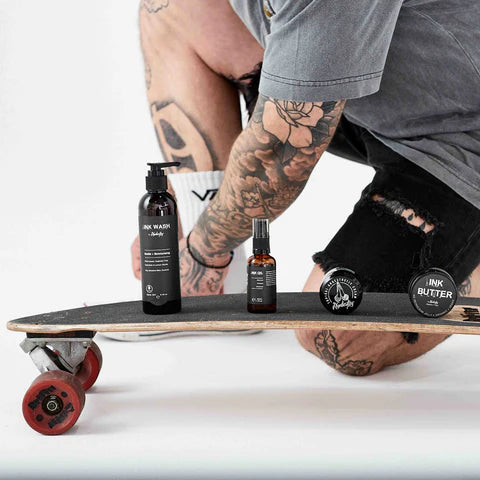How to Fix an Over-Moisturised Tattoo
Ensuring the proper care of your tattoo is paramount to preserving its beauty and integrity over time. Among the crucial elements of post-tattoo care, moisturising stands out as a vital step. An adequate moisturiser like Numbastay’s Ink Butter, not only prevents discomforts like itching and cracking but also safeguards against potential infections, ensuring your tattoo cream heals as intended. However, while a consistent moisturising routine is essential, it's equally important to be aware of the possibility of over-moisturising your tattoo, a condition that can lead to undesirable consequences for your ink.

Using too much moisturiser can or insufficient drying of the tattoo after exposure to water, can cause a buildup of moisture between the ink and the skin. This can manifest in the formation of gooey scabs or fluid-filled blisters, ultimately distorting the appearance of your tattoo. Recognising the signs of too much moisturiser and taking proactive measures to address them is crucial in maintaining the health and appearance of your ink.
The duration of your moisturising routine depends largely on the size and complexity of your tattoo, typically spanning from two weeks to three months. Most tattoo artists recommend moisturising your fresh ink once or twice daily, ideally after cleansing to ensure optimal hydration without excessive moisture buildup. Signs that you may be over-moisturising include irritated, inflamed skin and clogged pores, which can lead to breakouts. If you find yourself reaching for moisturiser excessively due to concerns about dryness, consulting your tattoo artist for guidance is advisable. In the next section let’s explore how to fix an over-moisturised tattoo
How to Fix an Over-Moisturised Tattoo:
- Cease Moisturising Immediately: Discontinue applying moisturiser to the affected area to prevent further moisture buildup.
- Gently Pat Dry and Allow Natural Drying: After showering, use a soft towel to gently pat the tattoo dry, then allow it to air dry for 15 to 30 minutes. Avoid excessive manipulation to prevent further irritation.
- Avoid Excessive Manipulation: Refrain from touching or picking at the tattooed area to allow the skin to naturally rebalance its moisture levels.
- Wait Before Reintroducing Moisturiser: Allow the skin to rest for at least a day before reintroducing moisturiser. This gives the skin time to adjust and prevents exacerbating effects of too much moisturiser.
- Apply Thin Layer of Moisturiser: When reintroducing moisturiser, apply a thin layer to the tattooed area to avoid overwhelming the skin and impeding the healing process.
For optimal tattoo care, selecting a high-quality moisturiser is essential. Numbastay offers an exceptional solution with its Numbastay Ink Butter or Numbastay Ink Oil. Formulated with natural humectants, these products provide the nourishment and hydration your tattoo needs to heal effectively. However, it's important to use these products judiciously to avoid over-moisturising your tattoo.
By following a balanced aftercare routine and being mindful of the signs of excessive moisturiser, you can ensure that your tattoo remains vibrant and healthy for years to come. Explore the range of Numbastay products available at our online store to give your tattoo the care it deserves.



